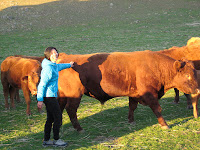Adopted from Ashland Co-housing Community
Turn off your TV
Leave your house
Know your neighbors
Look up when you are walking
Greet people
Sit on your stoop
Plant flowers
Use your library
Play together
Buy from local merchants
Share what you have
Help a lost dog
Take children to the park
Garden together
Support neighborhood schools
Fix it even if you didn't break it
Have potlucks
Honor elders
Pick up litter
Read stories aloud
Dance in the street
Talk to the mail carrier
Listen to the birds
Put up a swing
Help carry something heavy
Barter for your goods
Start a tradition
Ask a question
Hire young people for odd jobs
Organize a block party
Bake extra and share
Ask for help when you need it
Open your shades
Sing together
Share your skills
Take back the night
Turn up the music
Turn down the music
Listen before you react to anger
Mediate a conflict
Seek to understand
Learn from new and uncomfortable angles
Know that no one is silent though many are not heard
Work to change this
I briefly introduced the Ashland co-housing community in a previous blog. The concept has interested me for the last several years, so I was glad to have a brief first-hand experience at our friend Leah's place.
Like most community-anything, co-housing community takes a lot of hard work and perseverance to maintain its mission. Although leadership role naturally exists in a community, no one person (or persons) has authority over others. Most decisions are made by consensus. That can be challenging; such is the reality of living in a co-housing community.
Every household has part-ownership of the property; every household shares expenses of maintaining the common grounds through homeowner association dues; every household signs up for upkeep of the common grounds and chores. It is a community that emphasizes shared resources and living sustainably - hence, by default, active participation of some sort is required. It is also a community that everyone must learn to interact with each other, resolve conflicts, practice tolerance, and perhaps, believe in the good of the people. It has its rewards, and it has its work cut out.
 |
| The Welcome Committee at the entrance of the complex |
 |
| The Common House where meals, activities, regular meetings, and parties take place |
 |
| The Common House is a large 2-story space with full amenities for kids and adults |
 |
| Upstairs has a spacious guest room, where guests of all residents are welcome to stay. Guests may make a donation to the "general fund" if they'd like. |
 |
| Residents also enjoy a clean and comfortable yoga room |
Optional shared meals. What a tremendous concept and a huge relief for parents who have young(er) children. Imagine a living community where you know everyone. Imagine coming home and on "shared meals" day, there is a nutritious, wholesome meal already prepared for you and your children. Enjoy in the company of others, instead of the TV. Sure, there are dietary restrictions and preferences and this and that - but those are just details to be ironed out. The concept, the fabric of the concept, is tremendous.
"Love people. Cook them tasty food." ~ author unknown
 |
| Guests are welcome to use the Common House kitchen as their own. We met some friendly and generous souls while preparing dinner. |
 |
| Play area for the kiddies. World maps, books, games, comfy pillows. |
 |
| Everything is in a honor system - these aren't coin-op washing machines. |
 |
| "Family room" has a huge screen for movie nights |
 |
| "Bulletin Board" shares news about the community garden, general maintenance needed, activities, meeting minutes, sign up sheets for meals, etc. |
 |
| "Wherever you are, that is your platform. Please take responsibility for the energy you bring into this place." ~Oprah |
 |
| Bike barn is big enough to park bikes for all 13 households . Eric found the bike that he gave Leah more than a decade ago! |
 |
| Residents organize work parties in the community garden during growing season. Everyone is welcome to the produce, and everyone pitches in. Pick what you need. |
 |
| An outdoor play area is located immediately in front of the homes. |
 |
| Ashland Co-housing Community |



















































